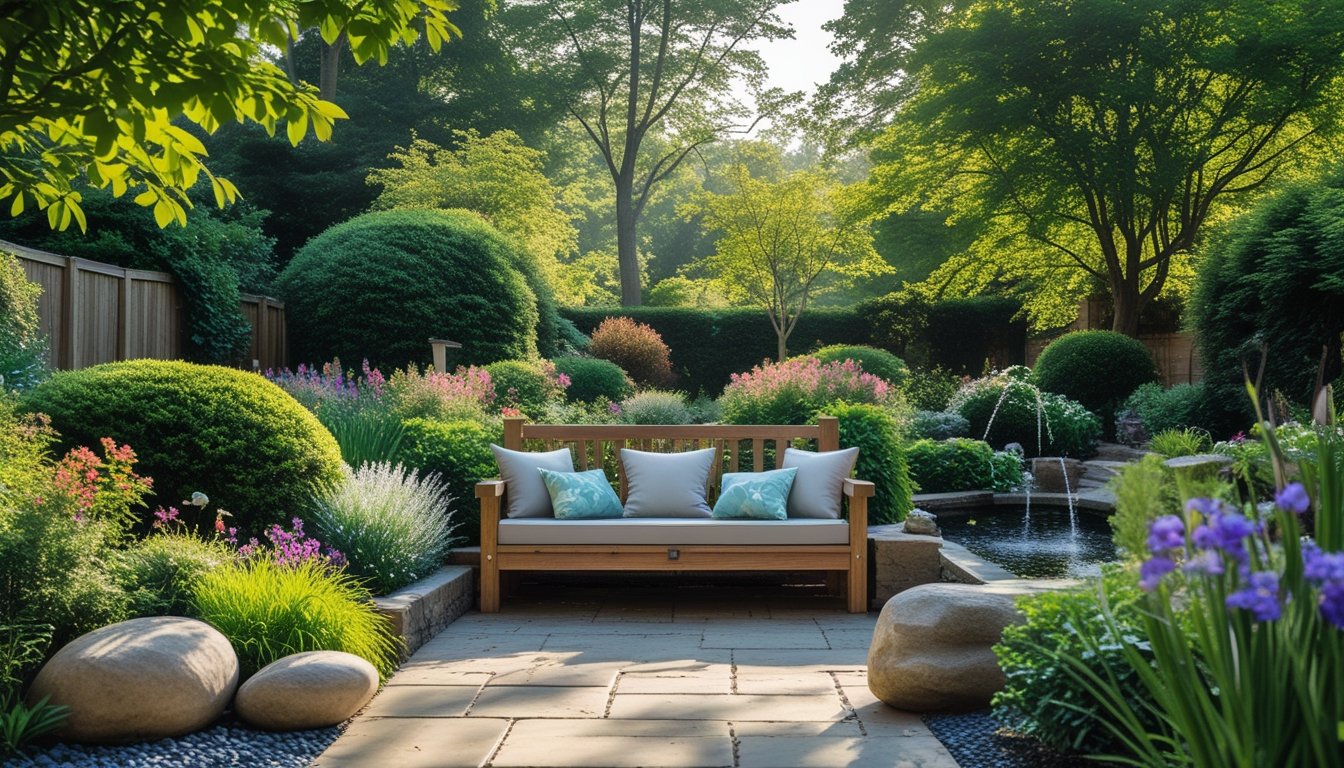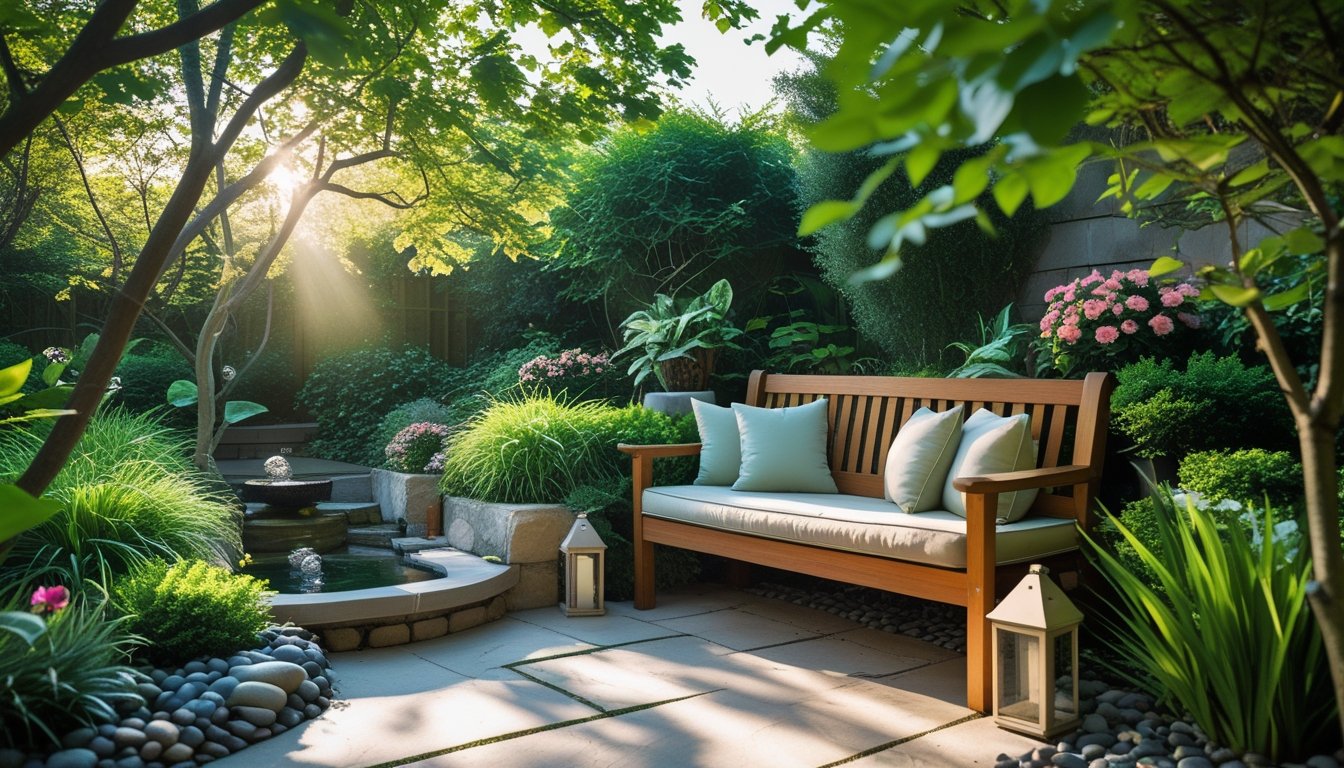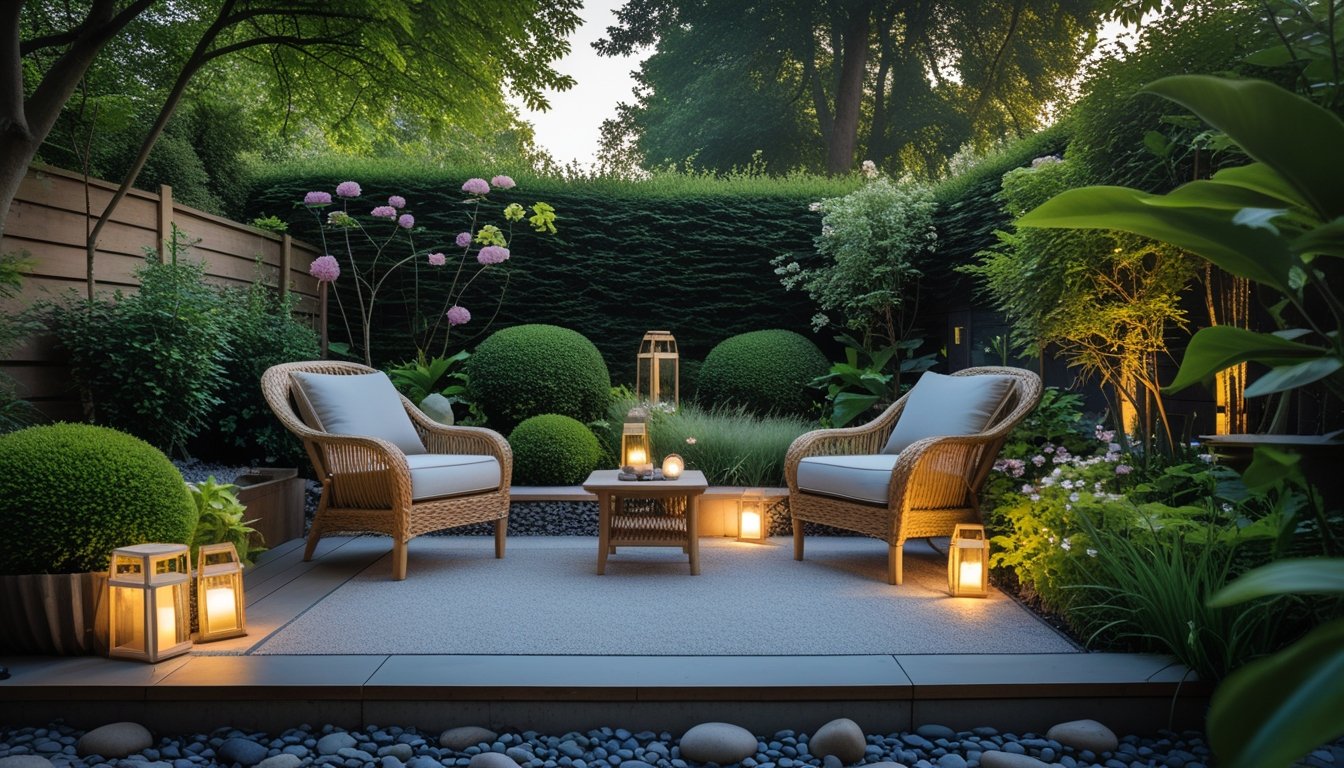Late updated: 28 Aug 2025 10:08
Written by: James Whitaker
Creating A Tranquil Garden Seating Area For Relaxation: Tips And Ideas
Creating a tranquil garden seating area is a wonderful way to transform an outdoor space into your personal sanctuary. Imagine stepping outside into a haven designed specifically for relaxation, where every element contributes to a sense of peace. The key to achieving this lies in combining carefully chosen seating, calming plant life, and soothing features that cater to your senses. Whether you have a large garden or a modest patio, creating this oasis is achievable with a few thoughtful design choices.

Our gardens should serve as retreats from the bustling everyday world, offering a place to unwind and recharge. Consider incorporating comfortable seating options, such as weather-resistant wicker chairs or classic wooden benches, paired with plush cushions to enhance your comfort. Adding ambient lighting, like string lights or lanterns, not only creates a warm atmosphere but allows for extended enjoyment into the evening.
Plants play a significant role in cultivating peace. By integrating aromatic varieties such as lavender or rosemary, we can enhance the garden's calming environment while also attracting beneficial wildlife. Water features and minimalistic design elements further contribute to creating a serene backdrop, making our garden the perfect place for reflection and relaxation.
Key Takeaways
- Combine seating, plant life, and features for peace.
- Choose comfortable furniture and ambient lighting.
- Use calming plants and water features for tranquillity.
Fundamentals Of Designing A Tranquil Garden Seating Area

Creating a tranquil garden seating area for relaxation involves careful planning and design. It requires assessing your outdoor space, picking the right location, choosing comfortable and suitable seating, and incorporating natural elements to foster a soothing environment.
Assessing Your Outdoor Space For Relaxation
Before anything else, we need to evaluate the existing features of our outdoor space. Identifying sunny and shaded areas, wind patterns, and focal points such as water features or stunning plants will help us decide where to create a calming garden nook. It's important to account for privacy, ensuring that our space remains a peaceful retreat.
Deciding whether a garden swing or a series of hammocks might be a better fit depends on how much room we have available. Having a clear picture of the space enhances our creativity and helps to ensure that our area remains inviting and functional.
Choosing The Ideal Location For Peaceful Seating
Selecting the best spot for our tranquil haven involves considering noise levels, views, and accessibility. A location away from street noise where natural sounds like birdsong can be appreciated is ideal for fostering calm. If possible, we should locate our seating near attractive garden features, such as a small pond or a patch of vibrant flowers, to maximise the peaceful garden atmosphere.
Accessibility is equally important. Paths lined with stepping stones or gravel can guide us smoothly to the seating area, encouraging regular use. Maintaining a balance between seclusion and accessibility is critical for an enjoyable experience.
Selecting Comfortable Seating Options
Comfort is paramount when choosing seating for our retreat. Options like garden sofas with weather-resistant cushions, hammock setups for gentle swaying, or a classic garden swing could fill our space with both style and ease. Cushions made from natural fibres add an extra layer of comfort without disrupting the natural ambiance.
Sofas and chairs with adjustable features allow us to customise our seating experience. For a more informal touch, oversized cushions or beanbags made from durable fabric can be scattered around. This variety lends itself to both individual relaxation and social gatherings.
Using Natural Materials For A Calming Atmosphere
Natural materials such as reclaimed wood, stone, and bamboo can contribute to the soothing environment we aim to create. Wood, particularly reclaimed, tends to blend seamlessly with greenery and provides an authentic, rustic charm that enhances relaxation. Incorporating stone elements like small benches or stepping stones introduces an earthy touch.
Bamboo screens or trellises can offer privacy while maintaining an open feel. The use of these materials not only underscores a commitment to sustainability but also integrates effortlessly with diverse plantings, thereby elevating our garden seating area to a peaceful retreat.
Enhancing Tranquillity Through Planting, Features And Ambience

In crafting a serene garden space, our focus is on lush greenery, soothing water elements, soft lighting, and artful styling. Each element serves to heighten the sense of relaxation and beauty in our garden retreat.
Selecting Fragrant And Lush Greenery
To evoke tranquillity, choosing fragrant and lush plants is essential. We recommend incorporating aromatic herbs like lavender, rosemary, and jasmine, which provide natural calming scents. Climbing vines such as wisteria and clematis can adorn trellises and pergolas, adding vertical interest.
Ferns, ornamental grasses, and various succulents offer textural diversity without overwhelming the senses. Use of planters and potted plants allows for flexibility in design, letting us adapt as our tastes evolve. Placing these near seating areas maximises their sensory impact, fostering a soothing environment.
Incorporating Water Elements And Soothing Sounds
The gentle sound of water can transform a garden into a tranquil sanctuary. We might consider adding features like a pond, various sizes of fountains, or elegant birdbaths. These water elements not only contribute to the aesthetic but also attract wildlife, enhancing the garden's vibrancy.
For those seeking simplicity, small rock gardens or zen arrangements with decorative stones and pebbles can replicate the soothing tones of water. Wind chimes may also introduce soft, melodious notes to our space, further enriching the peaceful atmosphere.
Adding Soft Lighting And Decorative Accents
Illumination plays a key role in setting the mood of our garden. Incorporating solar-powered lanterns, string lights, or delicate fairy lights can cast a warm, magical glow over evening gatherings. Pathway lights guide guests safely while adding a charming touch.
Additionally, stone lanterns provide both function and an artistic flair. The soft lighting enhances the evening landscape and encourages prolonged enjoyment of our outdoor retreat, irrespective of the time of day.
Styling With Textures, Accessories And Garden Art
In selecting accessories, blending textures can create a harmonious setting. Outdoor cushions and rugs in varying fabrics offer comfort and design flexibility. Positioning of elegant garden art, such as sculptures or intricate planters, can serve as focal points or subtly integrate into the background.
Beyond furniture, implementing structures like pergolas or whimsical trellises further diversifies our seating area's visual appeal. Every carefully chosen element contributes to a seamless environment where art, design, and nature converge, crafting a truly tranquil space.
Frequently Asked Questions

Transforming a garden into a tranquil retreat involves using creativity and practicality. From creating covered seating areas to incorporating peaceful elements, it's essential to consider different strategies. Here, we address common questions about designing a serene garden environment suitable for relaxation and leisure.
How can I create a covered seating area in my garden?
To design a covered seating area, consider pergolas or gazebos, which offer shade and shelter. These structures can be adorned with climbing plants like wisteria or ivy for natural beauty and a touch of privacy. Alternatively, simple canopies or large garden umbrellas provide cost-effective solutions and flexibility in terms of location.
What are some affordable garden seating ideas?
Affordable options include repurposing materials such as wooden pallets to create rustic benches and utilising existing tree stumps or rocks as natural seating. Adding colourful cushions and throws can enhance comfort and aesthetics without breaking the bank. Thrift shops might also offer unique second-hand furniture pieces at a lower price.
What are the best ways to set up a small sitting area in my garden?
Incorporate compact furniture like bistro sets or folding chairs, which take minimal space and offer versatility. Consider vertical garden elements to optimise space availability, allowing more room for seating. Position chairs in cosy corners, accented with small side tables to support a relaxed atmosphere.
Could you suggest some ideas for creating a peaceful garden retreat?
Introduce calming features like water fountains or ponds to add soothing sounds. Select aromatic plants such as lavender or jasmine to enhance the sensory experience. Consider incorporating pathways with stepping stones or gravel, encouraging quiet exploration of your sanctuary.
What are the essentials for designing a tranquil garden nook in a limited space?
Prioritise multifunctional furniture pieces that can be adjusted or moved easily. Use mirrors to create an illusion of space and include planters at different heights to optimise vertical space. Choose peaceful colours and textures for furnishings to maintain a calming ambience throughout the nook.
How can I integrate a peace garden concept into a school environment?
Engage students and staff in designing and maintaining the garden to promote ownership and care. Incorporate seating areas conducive to group discussions or solitary reflection. Introduce native plants and sensory areas to encourage environmental learning and appreciation, making the garden a valuable educational resource.
